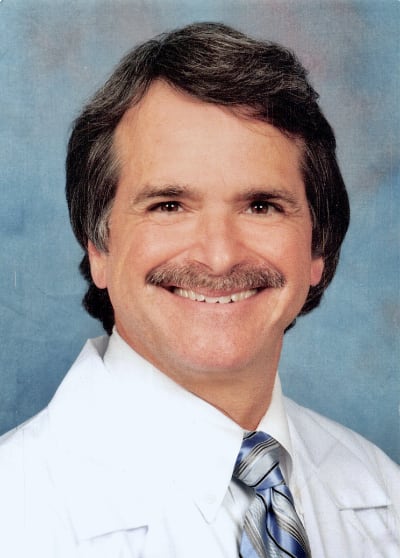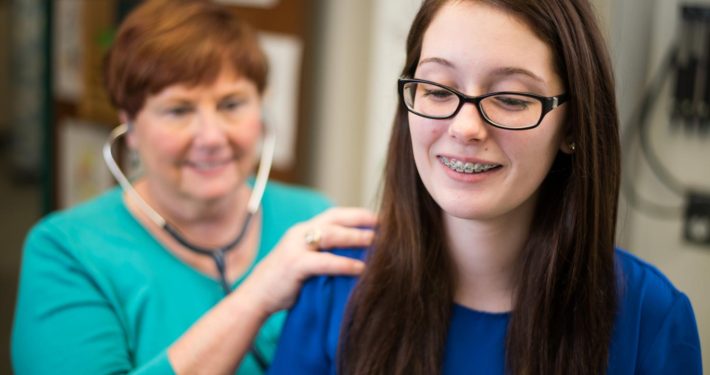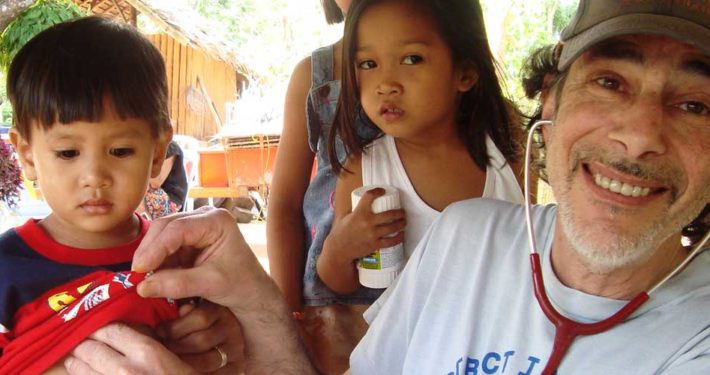Serving the Whole Family through Developmental Pediatrics
Dr. Mark Moncino is passionate about offering specialized care to children with developmental differences. He tells the story of discovering the holes in developmental screening and treatment, and the road to starting his own practice.
Personal Motivations Lead to Specialization
When Dr. Mark Moncino founded the Georgia Center for Autism and Developmental Pediatrics (GCADP), his goal was to support whole families as well as the individual child. “Families are essential supporters of kids with developmental differences,” says Dr. Moncino, “and they can also be the ones who are most confused on how to help.” GCADP is a specialized practice that serves a very specific population: children with developmental differences. Creating a unique space for this niche group was Dr. Moncino’s goal. “This is my way to give back to kids who not a lot of practitioners are able to help,” Dr. Moncino says, “because, through no fault of their own, they don’t have the training or the time. I’m very comfortable taking care of complicated patients, and in fact, it’s my passion.” During a fellowship at Duke University in pediatric oncology and hematology, Dr. Moncino discovered that he “that working with complicated children with special needs lit [him] up.”
Dr. Moncino’s practice was initially inspired by personal experience with developmental differences, both his own and his children’s. “In second or third grade, my kids started having problems in school, but their school didn’t realize it. Even though they were getting As, year after year their test scores on standardized reading and comprehension tests were dropping,” Dr. Moncino explains. “So we had our oldest tested and learned that he had a processing disorder. Then we had our second son tested and realized that he had severe dyslexia that the school hadn’t recognized. And neither had we, their parents who are both in medicine!”
Dr. Moncino continues, “I realized that I hadn’t learned about developmental differences in medical school. I realized, after being in medicine for 25 years, I didn’t know what the heck was going on with my child. And I wondered about the experience of parents without my background.” Statistics corroborate the Moncino family’s experience. In the U.S., one in five children have diagnosed learning and attention issues, but only a small subset receive specialized instruction in school and treatment from pediatricians.1
Following the revelations about developmental challenges in his family, Dr. Moncino wanted to fill the niche for development differences that have been historically difficult to treat. “Based on my kids’ experience, I started to see what happened to children with developmental differences… so in 2019, I was able to build a practice where I could care for patients who needed specialized care.” Dr. Moncino launched GCADP a few months before the start of the COVID-19 pandemic, but his practice generates about 50% of visits through telemedicine, so “Thankfully we haven’t faced major setbacks due to Covid,” he says.
What was his original motivation to open GCADP with heavy reliance on telemedicine? “I have been in a position since my pediatric hematology-oncology fellowship, and then ongoing, where telephone calls to parents to address quite detailed problems was the norm,” explains Dr. Moncino. “As we saw kids from all over the state, and parents sometimes drove three to five hours to see me, I continued the abundant use of telephone calls rather than making parents drive to see me to discuss problems that did not require an exam. While I was not ‘paid’ for these calls, it was the right thing to do, so I did them.” Dr. Moncino realized that his work was just as effective via telemedicine or video visits as it was in-person. “In my new practice, I have set up my fees to be no different for in-person or telephone or video visits, as what the parents are paying me for is my expertise, much of which can be provided over the phone, a video visit, or even a secure text message or Patient Portal email.”
GCADP offers a unique approach because of, not in spite of, its use of telemedicine. By using this modality, Dr. Moncino is able to work with many players in a child’s life, including parents, teachers, and general pediatricians.
“I realized that I hadn’t learned about developmental differences in medical school. I realized, after being in medicine for 25 years, I didn’t know what the heck was going on with my child. And I wondered about the experience of parents without a medical background.”Dr. Mark Moncino
Developmental Differences, Defined and Misdefined
The National Center for Learning Disabilities (NCLD) defines learning and attention issues as “brain-based difficulties in reading, writing, math, organization, focus, listening comprehension, social skills, motor skills or a combination.” The NCLD definition explicitly highlights that “learning and attention issues are not the result of low intelligence, poor vision or hearing, or lack of access to quality instruction.” Despite this negation of stereotypes around the cause of learning differences, public misinformation abounds, often resulting in the perception that children with learning disabilities are simply less intelligent. The International Dyslexia Association found that seven out of ten parents, educators and school administrators incorrectly linked learning disabilities with mental retardation.
Researchers are still working to uncover the causes of developmental differences, but have identified genetics, toxin exposure, and adverse childhood experiences (ACEs) as three contributing risk factors.2
Dr. Moncino speaks to both the lack of widespread information on and the stigma surrounding developmental and learning differences. Following his children’s diagnoses, Dr. Moncino realized he too had dyslexia. “It makes sense, as we know LDs (learning disabilities) can be genetic,” he says. “I used to think it was normal that I worked these crazy hours in medical school and college to get the A’s, but then I found out that not everyone had to work as hard as I did for as many hours to do well,” he recalls. “Based on my own challenges, I began to understand that developmental differences are even more challenging to treat because of the lack of understanding amongst my pediatric colleagues, as well as educators, and the silence around them, both in our broader culture and in the medical field.”
This cultural silence can lead to unfortunate misconceptions about developmental differences. Individuals with learning or developmental differences like dyslexia, ADHD or autism experience painful social stigma, which is due in part to misconceptions about these disorders. Learning Disability Quarterly reported in 2018 that “In a nationally representative public opinion poll, 50% of the general public agreed or strongly agreed with the statement that ‘learning disability’ was a term often used to describe a condition that could really be called laziness… Furthermore, one in five members of the public did not believe that children with LD were ‘just as smart as you and me.’”
Genetics
Learning and attention issues tend to run in families. Genes that can affect brain structure and chemistry get passed down from parent to child.
Toxin Exposure
Exposure to lead and other environmental factors have been linked to ADHD and other issues that impact learning, attention, and behavior.
Adverse Childhood Experiences
Trauma, such as abuse, neglect, and other adverse childhood experiences, can increase the likelihood of being identified with learning or behavior issues.
This troubling finding indicates a need for public education around learning differences, particularly for teachers, school personell, and pediatricians who interface with children with LDs regularly. The study continues: “In the same poll, more than half of the public, a similar number of parents, 43% of teachers, and 31% of educational administrators believed LDs were often caused by conditions at home.” While LDs can be caused by ACEs, other contributing factors have little to do with a child’s home life, their relationship with their parents, or their level of food and housing security (see above graphic for risk factors).
Aside from painful social stigma and its consequences, children with LDs are more likely than non-LD peers to suffer from low emotional well-being. A study in the Journal of Adolescent Health found that “adolescents with learning disabilities had twice the risk of emotional distress, and females were at twice the risk of attempting suicide and for violence involvement than their peers.” The study concluded that community and relationships are essential to mitigating these problems. Researchers found that “connectedness to parents and school was identified as most strongly associated with diminished emotional distress, suicide attempts, and violence involvement among adolescents with learning disabilities.”3
A 2019 study published in NCBI found that participation in social and educational communities is key for the emotional and psychological health of children with LDs. Defining participation as “involvement in life situations, researchers found that “children with disabilities are at significant risk for limited participation in school. Such restrictions have significant lifetime consequences for achievement, quality of life and wellbeing… Attendance for children with disabilities is reduced compared to peers. Students with disabilities participate less in structured and unstructured activities, and experience reduced interaction. Children with disabilities additionally show less engagement in the wider school world, including clubs and organizations.” As participation in school for children with LDs has been linked to improved health, well-being, and academic performance, it is important for caregivers to choose environments and systems that support participation.
Challenges for Caregivers
Social stigma not only impacts children with learning disabilities, but harms their caregivers as well. A 2019 study published the Journal of Autism and Developmental Disorders found “the impact of autism related stigma upon caregiver mental health to be significant, meaningful and complex,” and that “informal caregivers of autistic individuals (i.e. people who provide unpaid care and support to a family member in a non-professional capacity) are at a substantially elevated risk of poorer mental health compared to the general population.” These “informal caregivers” tend to be parents, siblings, grandparents or other relatives. In autism specifically, poor mental health in caregivers is attributed to “the blaming of caregivers for the onset of autism and deterioration of their child’s development, an expectation that they should be ashamed, that they lack competence in their caregiving role, and that it is best if they are avoided and/or pitied.” Informal caregivers can also experience “affiliate stigma.” In this case, public stigma and stereotypes towards LD children and their caregivers subsequently become accepted by caregivers and absorbed into their own psychological identity. Basically, informal caregivers “self-stigmatize,” and experience greater levels of anxiety and depression.4
These kinds of challenges frame Dr. Moncino’s approach to care. “I know in my practice that it is essential to serve the child and the family,” he says. “A big part of what I do is family support and education.”
“Every single child wants to do well. They want to please their parents and teachers; they want to work as hard as possible. Treating learning differences is not about a child’s motivation, but rather it’s about giving them the tools to succeed.”Dr. Mark Moncino
Change Management and a Whole Family Approach
Dr. Moncino’s approach at GCADP is grounded in the idea that “kids do well if they can.” He acknowledges that he borrowed this idea from psychologist Ross Greene, who delivered the tenet at a medical conference. “At the time, this was one of the most enlightening statements I’d ever heard about pediatrics,” says Dr. Moncino. “Every single child wants to do well. They want to please their parents and teachers; they want to work as hard as possible. Treating LDs is not about a child’s motivation, but rather it’s about giving them the tools to succeed. If a child is not doing well, it is up to us, the parents, teachers and the pediatricians, the adults in the room to figure out what tools, tricks or accommodations are necessary.”
Dr. Moncino does offer the caveat that children, especially adolescents, who have experienced significant shame, blame or trauma around their developmental difference may lack motivation. “Eventually, children with unrecognized and thus unaccommodated LDs can feel squelched and turn in on themselves, and no longer care about academic success. They can become socially isolated, and frankly sad, depressed, and disinterested in school,” he explains. “But this reaction isn’t intrinsic; it’s coming from overwhelming academic demands, and blaming the child for poor academic performance or labeling them as ‘not trying,’ when indeed, they are trying, they just need accommodations to succeed. If The LD is not recognized, those accommodations can’t be provided.”
Dr. Moncino continues, “This kind of closing off doesn’t typically happen in early childhood. The implication is that if a child isn’t doing well academically or socially, it is our job, the job of the adults taking care of the child, to help figure out what is getting in the way of that child’s success.” These roadblocks can be discovered, says Dr. Moncino, through the process of change management, a model borrowed from the business world. Change management encourages pediatricians to meet children at their current developmental level, guiding them to adapt to changes in small increments. “Incremental changes over time lead to success,” says Dr. Moncino.
“Change management occurs with both kids and families,” he continues. “Often, parents come in because they are upset with their child. For example, a parent may bring in a kid with anger management issues, but the kids may not care or want to change. I try to help parents recognize that their child won’t change overnight, and that’s okay. We ask the question: how can we break this issue into small incremental steps where kids complete a task, are rewarded, and then build confidence?” To support these small changes, Dr. Moncino takes a holistic approach. He sees his role as the “head of a child’s developmental home,” meaning he synthesizes information from pediatricians, contracted therapists, and educators to support families in meeting their goals.
He offers the example of anger, or misbehavior. “If a kid is acting out, we can take a step back and consider the challenges that this kid is facing,” says Dr. Moncino. His approach involves looking beyond the pediatric office and the home and unpacking the child’s experience at school. “Are the tasks at school outside of that child’s skill set or current ability? If they keep getting tasked with something they can’t do, they will of course get frustrated and angry. We have to identify what problems we can work on with kids to help them succeed.”
Dr. Moncino also finds it helpful to frame childhood behavioral change in the context of potential adult behavioral change. “If behavioral change was easy, none of us would smoke. None of us would drink to excess!” he explains. “All of us would be exercising daily. But we all understand how difficult behavioral changes are.” Dr. Moncino encourages family members to build empathy with their child by considering the challenges they’ve faced in their own attempts at behavior change. “If they can build empathy, they can build patience,” he says.
Integrating Developmental Pediatrics into General Practice
It’s no secret that pediatricians can be overworked. If many pediatricians already lack the desired amount of time with patients, how can they incorporate yet another specialty for kids with developmental challenges?
“You don’t need to be a specialist to serve kids with developmental differences,” says Dr. Moncino. “My biggest recommendation for general peds is using standardized assessments as a screening for new patients.” The AAP offers many tools to support pediatricians in screening and identifying developmental disorders, and then to intervene successfully. Dr. Moncino points to STAR Center (Screening, Technical Assistance & Resource Center) for pediatricians to explore the what, why and how of developmental screening.
A 2015 study in Pediatrics reports that “behavioral and emotional problems during childhood are common, often undetected, and frequently not treated despite being responsible for significant morbidity and mortality. By current estimates, approximately 11% to 20% of children in the United States have a behavioral or emotional disorder at any given time.” Researchers suggest that behavioral, emotional and developmental screenings should be included in any well visit from early childhood through adolescence.
Then, Dr. Moncino encourages general pediatricians to follow up with parents as much as possible. “We must recognize that we’re not as good as we think we are — we can’t do everything in the 15 minute double-booked well child check appointment,” he says. “It’s difficult to do the well check, then have the parent come back and address what we screened for, but it’s essential. We must break the problems down into manageable sized teaching moments for the parents and create specific action items for them to address, and then follow up.”
Ultimately, Dr. Moncino believes that the best way to serve all children is to collectively shift the culture of the overbooked physicians. “I know that general peds are maxed out, are trying to get through add-on patients, and make it to the end of the day,” he says. “But if you do the screening during well-visits, if you ask the questions, it’s amazing how much pathology you can find. We as physicians have to view these developmental screenings are essential; we need to stop the train on overfull schedules for pediatricians.”
Perhaps due to the nature of his specialty, his patients, and his own struggle with dyslexia, Dr. Moncino sees the importance of correctly allocating our time. “Often, we put value on things based on the amount of time we give to them,” he says. “The biggest factor that could contribute to general pediatricians catching developmental challenges is giving the pediatrician more face time with kids and families, whether that’s in the office or electronically.”
Emily Graf is a freelance writer, wilderness educator, and English teacher living in Colorado. She is passionate about telling stories that promote equal access to quality health care. She can be contacted at emgraf11@gmail.com for inquiries.










